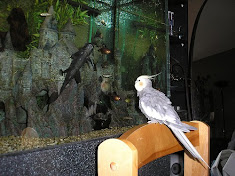As of September 1, 2010, eleven of our fifty states have Official State Dogs or officially recognized state dogs. Listed below, in alphabetical order, are the states, their state dog and the year it was made official, along with a little bit about each dog breed. To see a larger picture of any of the dogs, just click on its picture. Photo credits, where applicable, can be seen with the larger pictures. This list will be updated as more states recognize our furry friends.
Alaska, Alaskan Malamute, 2010
Descended from the dogs of the Mahlemuts tribe of northwestern Alaska, Malamutes are equipped with a dense double coat, making them much more suited to a colder climate than a warm one. While still used for sledding, heavy pulling and the sport of mushing, the majority of Malamutes are now family pets or show or performance dogs.
Louisiana, Louisiana Catahoula Leopard Dog, 1979
Named after the Catahoula Parish in Louisiana, it is believed the Catahoula cur is the oldest breed of dog that still remains in North America, not counting those dogs descended from Native American-created breeds. This very intelligent and energetic dog needs at minimum an hour's worth of exercise each day. A social animal, Catahoula's will not tolerate isolation. These dogs are at their best when active and occupied with a task or chore, making them excellent hunting and tracking dogs.
Maryland, Chesapeake Bay Retriever, 1964
Developed during the 1800's in the Chesapeake Bay area, this breed's love of water contributes to its heavy use in retrieving waterfowl. Chessies are intelligent dogs, with a happy disposition and protective, affectionate nature. If socialized from an early age, they can make excellent family dogs. More solitary Chessies can be somewhat assertive and pensive around strangers, making those dogs better suited for guard dog duty.
Massachusetts, Boston Terrier, 1979
The Boston Terrier, also known as the "American Gentleman", is a highly intelligent and lively breed. Bostons were initially bred for fighting, then bred down for human companionship. When properly socialized, Bostons get along well with young and old, canine and non-canine alike. Because of the shortened muzzle of the Boston, extreme temperatures are difficult for the dog to tolerate and demanding exercise in severe extremes can bring harm to Bostons.
New Hampshire, Chinook, 2009
This rare breed of sled dog was developed in the early 20th century in New England. Being muscular and well-balanced, some Chinooks are used for search and rescue and sport trials, such as skijoring, where two dogs pull a person on skis. As for temperament, it's hard to beat a Chinook - they're friendly, calm and non-aggressive. They're good with children, strangers and other animals. With this laid-back personality, though, they might not be the best watchdog.
North Carolina, Plott Hound, 1989
A little known breed in the US, these wild boar hunting hounds were brought to the States from Germany by Johannes Plott in 1750. They are intelligent, active, courageous, fast and alert. Their treeing instinct is superb, they love the water and fight viciously on game. They enjoy human companionship and make good family pets for those without small children, due to their innate hunting instincts.
Pennsylvania, Great Dane, 1965
Great Danes, the "Apollo of all breeds", are best known for their massive size. Currently, the largest dog of this breed and the tallest ever according to Guinness World Records is George, who measures 7.2 ft (220 cm) from head to tail. George weighs in at a svelte 245 pounds. His sleeping quarters are a queen-sized bed. He rides around his Tucson neighborhood in a golf cart. While a Great Dane's shear size may intimidate some people, they are typically docile, referred to frequently as Gentle Giants.
South Carolina, Boykin Spaniel, 1985
Boykin Spaniels, bred for wild turkey hunting, are similar to Cocker Spaniels, but are more dense body weight-wise. Their color will only be chocolate or liver. Boykins are excellent swimmers; however, like most Spaniels, they are prone to ear infections and care must be given to their ears after time in the water. The Boykin's stamina in hot weather makes it a preferred waterfowl hunter in the Southeastern states. Easily carried in a small boat or canoe, Boykins have been called "the dog that doesn't rock the boat".
Texas, Blue Lacy, 2005
Although called blue, the Lacy can be brown or cream or a tri-color with a blue base. The Lacy is the only dog breed to have originated in Texas. Strong and fast, Lacys are an excellent choice for running trap lines, herding livestock and treeing game. Having a short, tight coat, Lacys need little in the way of grooming. Although eager, intelligent and easy to train, the Lacy's natural energy may be too much for small children to handle.
Virginia, American Foxhound, 1966
As the name implies, these dogs were bred to hunt foxes. As is typical with hounds, they need plenty of exercise and socialization. A bored foxhound can quickly wreak havoc in a house if left alone and restless. The hunting instinct of the foxhound is so strong it is not wise to allow him to be off-lead. A foxhound will follow a scent he has picked up regardless of commands given.
Wisconsin, American Water Spaniel, 1985
The American Water Spaniel could well be called the Triple Hunter. The AWS hunts feather, fur and even, yes, fish. Competent at retrieval, the breed also excels at flushing. This dog will take to the alpha of the household and needs to be trained consistently, with a fair hand. With a reputation for having its own mind at times, it is up to the owner of an AWS to let the dog know exactly what is expected of it.
Article Resource: Written by Starr Hendon
Subscribe to:
Post Comments (Atom)














1 comments:
Interesting post, particularly the choice of breed for each state. Thanks for the information and for visiting our site!
September 16, 2010 at 5:52 PMPost a Comment